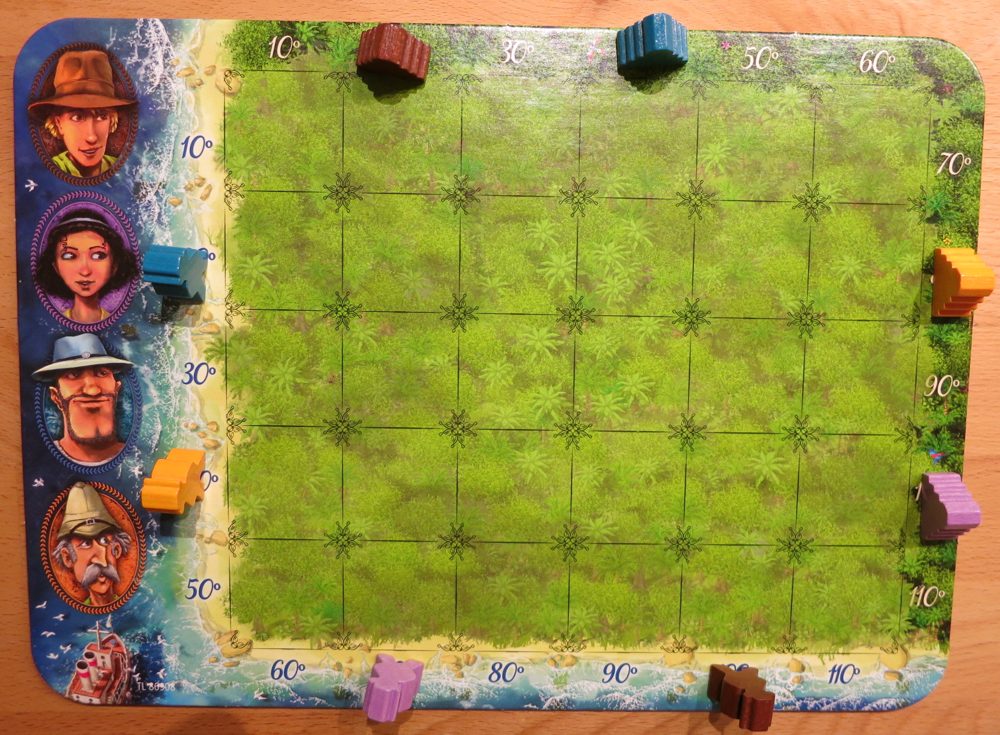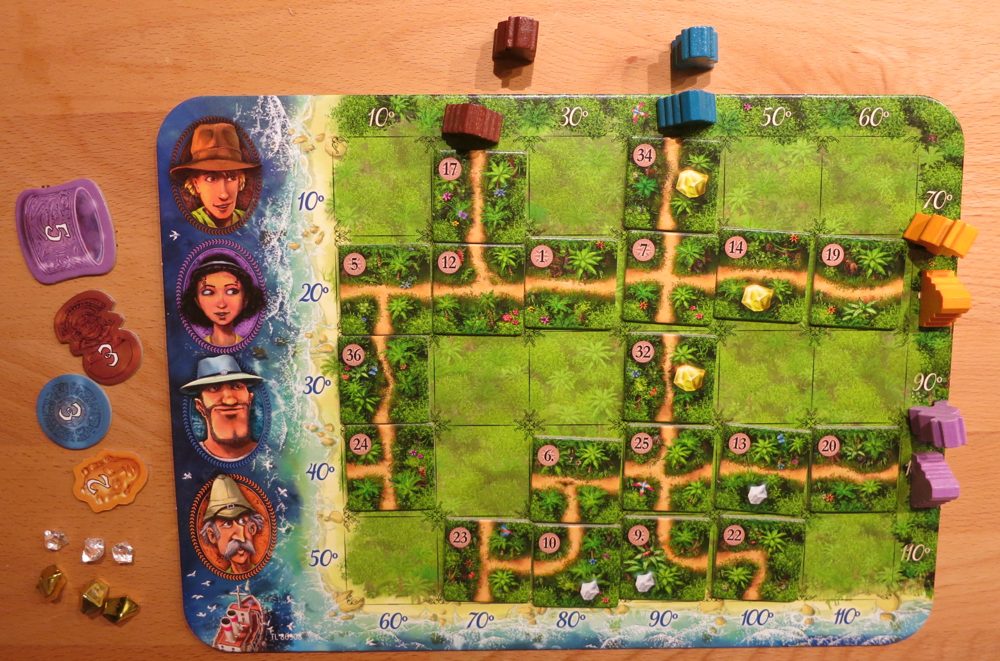
HABA is well-known for its line of games for younger children, easily recognizable by the distinctive bright-yellow boxes. Recently, HABA started to branch out into family games. With one of their very first titles for families, Karuba, they immediately scored a nomination for the German Spiel des Jahres (game of the year) 2016. Is the nomination deserved?
After having spent a rainy day cooped up in a smallish Swedish summer house with my family doing little else than playing game after game after game of Karuba, my answer is a resounding “Yes!” Several game publishers print on the boxes of their games classifications, rating the game in categories such as “strategy”, “luck factor”, etc. HABA has invented the somewhat dubious “addictiveness factor”, for which it gives Karuba full marks. “Dubious”, because it smacks just a bit too much of marketing rather than factual information about the game. But I have to hand it to HABA: Karuba definitely is addictive.
So, what is it all about? Karuba sends you and your fellow players on a treasure hunt in the jungle. Each participant plays on a separate board, a 5×6 grid, with four adventurers (in colors brown, blue, purple, and yellow) lined up at the edge of the jungle (i.e., the left hand and lower side of the grid) and four temples (in corresponding colors) in the heart of the jungle (i.e., the right hand and upper side of the grid). These positions are varied from game to game (the players take turns in placing adventurers and temples), but within a game, all players start out with the same setup.

Each player tries to get his adventurers as fast as possible to the corresponding temple: the brown adventurer must reach the brown temple, the blue adventurer the blue temple, and so on. The player who reaches a given temple with the corresponding adventurer first, scores five treasure points, the next player receives four treasure points, etc. Along the way, adventurers may collect crystals (one treasure point each) and gold nuggets (two treasure points each).
In order to move through the jungle, the adventurers need paths. Those are created using tiles: a designated player draws a random tile and tells the other players its number, so that they can select the same tile from their set of tiles. The tile is then placed by each player anywhere on the player’s grid, the only rule being that the tile must not be rotated. Whenever a tile displays a crystal or a gold nugget symbol, a corresponding playing piece is placed on the tile; it may be collected when an adventurer reaches the tile and stops there for the turn. So how do adventurers move? Instead of placing a tile on her board, a player may discard the tile, allowing her to move one adventurer along the existing paths for up to as many fields as the discarded tile has exiting paths (two for a straight path or a curve, three for a T-crossing, and four for a full crossing).

In theory, two players might play exactly the same game by always making exactly the same moves, i.e., placing the tile at the same position and moving the same adventurer to the same field in each turn … but that never happens. Each player starts working on her own idea of how to best create a system of paths in the jungle, chosing the best places for the rare crossings such that no adventurer is cut off from his temple and putting the crystals and nuggets such that one of the adventurers will have opportunity to collect them.
This is a game where the participants in a way play alongside – after all, each player has her own board and there is no way in which one player can interfere with the plans of another player. That being said, though: The bonus for the first adventurers to reach a particular temple adds enough competition to make the participants feel that they are really playing against each other: Every time my kids reached a temple before anyone else, they gave a whoop of joy.
Why is Karuba so addictive? The main factor, I think, is that Karuba combines competition with puzzle solving. Finding an elegant solution to laying out the tiles such that all adventurers reach their temples and pick up lot’s of crystals and nuggets on the way is just very satisfying. If you do succeed, you want to succeed again; if you failed, you want to have another try and do better.

Like I said: when we got started playing Karuba, we played game after game after game. At the moment, the Karuba fever has abated a bit, but is likely to flare up again as soon as we sit down and play another round.
HABA recommends Karuba (the rules can be accessed online) for eight years and up, but with a bit of assistance, also seven-year-olds are likely to get addicted to the game.


